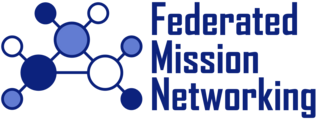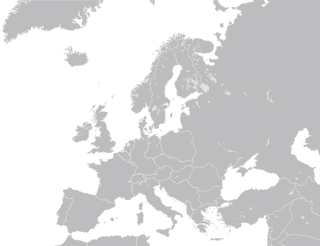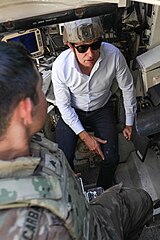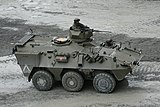
The Lithuanian Armed Forces are the military of Lithuania. The Lithuanian Armed Forces consist of the Lithuanian Land Forces, the Lithuanian Naval Force, the Lithuanian Air Force and the Lithuanian Special Operations Force. In wartime, the Lithuanian State Border Guard Service becomes part of the Lithuanian Armed Forces. A special security department handles VIP protection and communications security.

The Army of the Republic of North Macedonia is the military of North Macedonia. The army is organized, prepared and trained to conduct armed struggle and combat and other actions to achieve its constitutional function of defending the independence and territorial integrity of North Macedonia. The army consists of the ground forces and the air force, which are further divided into branches and services. The army has a permanent composition and reserve forces. Since 2005, it is a fully professional defense force compatible with NATO standards. On 27 March 2020, North Macedonia joined NATO as the 30th member.

The International Security Assistance Force (ISAF) was a multinational military mission in Afghanistan from 2001 to 2014. It was established by United Nations Security Council Resolution 1386 pursuant to the Bonn Agreement, which outlined the establishment of a permanent Afghan government following the U.S. invasion in October 2001. ISAF's primary goal was to train the Afghan National Security Forces (ANSF) and assist Afghanistan in rebuilding key government institutions; it gradually took part in the broader war in Afghanistan against the Taliban insurgency.

The Supreme Headquarters Allied Powers Europe (SHAPE) is the military headquarters of the North Atlantic Treaty Organization's (NATO) Allied Command Operations (ACO) that commands all NATO operations worldwide. SHAPE is situated in the village of Casteau, near Mons, Belgium.

The Norwegian Army is the land warfare service branch of the Norwegian Armed Forces. The Army is the oldest of the Norwegian service branches, established as a modern military organization under the command of the King of Norway in 1628. The Army participated in various continental wars during the 17th, 18th, and 19th centuries as well, both in Norway and abroad, especially in World War II (1939–1945). It constitutes part of the Norwegian military contribution as a charter member of the North Atlantic Treaty Organization (NATO) since 1949.

The Royal Danish Air Force (RDAF) is the aerial warfare force of the Kingdom of Denmark and one of the four branches of the Danish Armed Forces. Initially being components of the Army and the Navy, it was made a separate service in 1950. Its main purpose is to serve as enforcer of Danish airspace and to provide air support to Danish group troops on the battlefield.
The Allied Rapid Reaction Corps (ARRC) is a rapid reaction force maintained by NATO. It is capable of deploying a High Readiness Force (Land) Headquarters at short notice for operations and crisis response.

The Norwegian Armed Forces is the military organization responsible for the defence of Norway. It consists of five branches, the Norwegian Army, the Royal Norwegian Navy, which includes the Coast Guard, the Royal Norwegian Air Force, the Home Guard, and Norwegian Cyber Defence Force as well as several joint departments.

The Common Security and Defence Policy (CSDP) is the European Union's (EU) course of action in the fields of defence and crisis management, and a main component of the EU's Common Foreign and Security Policy (CFSP).

The Ukrainian Air Force is the air force of Ukraine and one of the seven branches of the Armed Forces of Ukraine. Its current form was created in 2004 by merging the Ukrainian Air Defence Forces into the Air Force.

Allied Joint Force Command Brunssum (JFCBS) is a NATO command with its headquarters at Brunssum, the Netherlands. It was established in 2004, as part of a reorganisation that reduced the number of NATO Military Command Structure headquarters.
Mission command, also referred to as mission-type tactics, is a style of military command, which is derived from the Prussian-pioneered mission-type tactics doctrine, combines centralized intent with decentralized execution subsidiarity, and promotes freedom and speed of action, and initiative within defined constraints. Subordinates, understanding the commander's intentions, their own missions, and the context of those missions, are told what effect they are to achieve and the reason that it needs to be achieved. Subordinates then decide within their delegated freedom of action how best to achieve their missions. Orders focus on providing intent, control measures, and objectives and allow for greater freedom of action by subordinate commanders. Mission command is closely related to civilian management concept of workplace empowerment, and its use in business has been explored by writers such as Bungay (2011) and Tozer. It is advocated but not always used by the militaries of the United States, Canada, Netherlands, Australia and the United Kingdom. Mission command is compatible with modern military net-centric concepts, and less centralized approaches to command and control (C2) in general.

Command and control is a "set of organizational and technical attributes and processes ... [that] employs human, physical, and information resources to solve problems and accomplish missions" to achieve the goals of an organization or enterprise, according to a 2015 definition by military scientists Marius Vassiliou, David S. Alberts, and Jonathan R. Agre. The term often refers to a military system.

The Estonian Air Force is the aviation branch of the Estonian Defence Forces. The air force traces its history to 1918, and was re-established in its current form in 1991.
The Structure of the North Atlantic Treaty Organization is complex and multi-faceted. The decision-making body is the North Atlantic Council (NAC), and the member state representatives also sit on the Defence Policy and Planning Committee (DPPC) and the Nuclear Planning Group (NPG). Below that the Secretary General of NATO directs the civilian International Staff, that is divided into administrative divisions, offices and other organizations. Also responsible to the NAC, DPPC, and NPG are a host of committees that supervise the various NATO logistics and standardisation agencies.

Icelandic Air Policing is a NATO operation conducted to patrol Iceland's airspace. As Iceland does not have an air force, in 2006 it requested that its NATO allies periodically deploy fighter aircraft to Keflavik Air Base to provide protection of its airspace. The first deployment of aircraft took place in May 2008.
A battlefield management system (BMS) is a system meant to integrate information acquisition and processing to enhance command and control of a military unit through multiple other C4ISR(Command, Control, Communications, Computers, Intelligence, Surveillance and Reconnaissance) solutions to give commanding officers, NCOs or individual vehicles better situational awareness to friendly units around them and prevent "blue on blue" incidents, provide better situational awareness to OPFOR units seen by friendly units, speed relaying of orders and thus accelerate combat operations and maneuvers, facilitating fire support orders as an enemy can be marked by a squad leader on his terminals map and then have the location relayed directly to artillery, CAS or other firesupport

Enhanced Forward Presence (EFP) is a NATO-allied forward-deployed defense and deterrence military force in Northern, Central and Eastern Europe. This posture in Northern Europe through Estonia, Latvia, and Lithuania and in Central Europe through Poland, Slovakia and Hungary and in Eastern Europe through Romania and Bulgaria, is in place to protect and reassure the security of NATO's Northern, Central and Eastern European member states on NATO's eastern flank.

Federated Mission Networking (FMN) is a significant initiative to help ensure interoperability and operational effectiveness of the North Atlantic Treaty Organization, it is a key contribution to the Connected Forces Initiative, helping Allied and Partner forces to better communicate, train and operate together. This includes the NATO Command Structure as well as the NATO Force Structure. The purpose of FMN is ultimately to support Command, Control, Communications, Computers, Intelligence, Surveillance and Reconnaissance (C4ISR) and decision-making in operations by enabling a rapid instantiation of mission networks. Including the NATO Command Structure, 37 nations have joined the FMN initiative as so called "FMN Affiliates" and work together under the FMN Framework Process to coordinate the design, development and delivery of operational and technical capabilities required to conduct net-centric operations. Each development increment is referred to as an "FMN Spiral". The respective requirements, architecture, standards, procedural and technical instructions are documented in so called "FMN Spiral Specifications". FMN Spiral Specifications are based on well known standards and best practices, hence supported by most off-the-shelf products and vendor neutral. TACOMS standards and profiles specify a common, technology and topology independent network interoperability layer for federated mission networks. There is also a rolling 10-year FMN Spiral Specification Roadmap of the envisioned future capabilities. At the same time, the Coalition Interoperability Assurance and Validation (CIAV) process ensures that current interoperability issues are being identified and fed back into FMN capability development.

The history of the North Atlantic Treaty Organization (NATO) begins in the immediate aftermath of World War II when British diplomacy set the stage to contain the Soviet Union and to stop the expansion of Soviet power in Europe. The United Kingdom and France signed, in 1947, the Treaty of Dunkirk, a defensive pact, which was expanded in 1948 with the Treaty of Brussels to add the three Benelux countries and committed them to collective defense against an armed attack for fifty years. The British worked with Washington to expand the alliance into NATO in 1949, adding the United States and Canada as well as Italy, Portugal, Norway, Denmark, and Iceland. Greece and Turkey joined in 1952, West Germany joined in 1955, Spain joined in 1982, Czech Republic, Hungary and Poland joined in 1999, Bulgaria, Estonia, Latvia, Lithuania, Romania, Slovakia, and Slovenia joined in 2004, Albania and Croatia joined in 2009, Montenegro joined in 2017, North Macedonia joined in 2020, Finland joined in 2023, and Sweden joined in 2024.



























